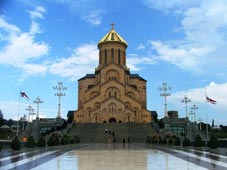The symbol of the Georgian national and spiritual revival
Friday, April 9

In May 1989 the Georgian Orthodox Patriarchate and the Tbilisi authorities announced an international contest to design the Holy Trinity Cathedral to commemorate the 1,500 years of the autocephaly of the Georgian Orthodox Church and 2,000 years from the birth of Jesus Christ. 1989 was a crucial year for the then-Soviet Republic of Georgia but the idea of building a new cathedral filled the people with hope for a better future.
It was difficult to identify the best entry despite the huge number of participants. No winner was chosen in the first round of the contest, to which more than a hundred projects were submitted. But finally architect Archil Mindiashvili's design proved the winner.
The subsequent turbulent years of civil unrest deferred this grandiose plan for six years, and it was not until November 23, 1995 that the foundation stone of the new cathedral was finally laid. The construction of the church was sponsored by mostly anonymous donations by several businessmen and common citizens of Georgia.
The cathedral was consecrated by Catholicos-Patriarch of All Georgia Ilia II and the high-ranking representatives of fellow Orthodox churches around the world on St. George's Day on November 23, 2004. The consecration was also attended by the leaders of other religious and confessional communities of Georgia and political leaders.
Sameba Cathedral is built on the Elia Hill, which rises above the left bank of the Mtkvari River in Avlabari in Old Tbilisi. The Cathedral represents a synthesis of traditional styles of Georgian church architecture at various stages of its history but also contains several innovations. Sameba is a cruciform church crowned with a dome over a crossing, which rests upon eight columns. At the same time the parameters of the dome are independent from the apses, imparting a more monumental look to the dome and the church in general. The dome is surmounted by a 7.5 metre-high cross covered with gold.
The cathedral consists of chapels dedicated to the Archangels, John the Baptist, Saint Nino, Saint George, Saint Nicholas, the Twelve Apostles, and All Saints, five of them situated in a large underground compartment. The overall area of the cathedral, including a large narthex, is 5,000 square metres and it occupies 137 cubic metres of space. The inner perimeter of the church is 56m by 44m. The height of the cathedral from the ground to the top of the cross is 84 metres. The underground chapel occupies 35,550 cubic metres and is 13 metres tall.
Natural materials have been used in its construction. The floor is made of marble tiles and the altar will also be decorated with mosaics. Murals are being painted by a group of artists led by Amiran Goglidze. The whole Sameba complex consists of the main cathedral church, a free-standing bell-tower, the residence of the Patriarch, a monastery, a clerical seminary and theological academy, several workshops, places for rest, etc.
The Holy Trinity Cathedral has become the symbol of the Georgian national and spiritual revival. Thousands of faithful attend liturgies there and pray for the peace and unity of their country, asking God for blessings and waiting for a miracle.
